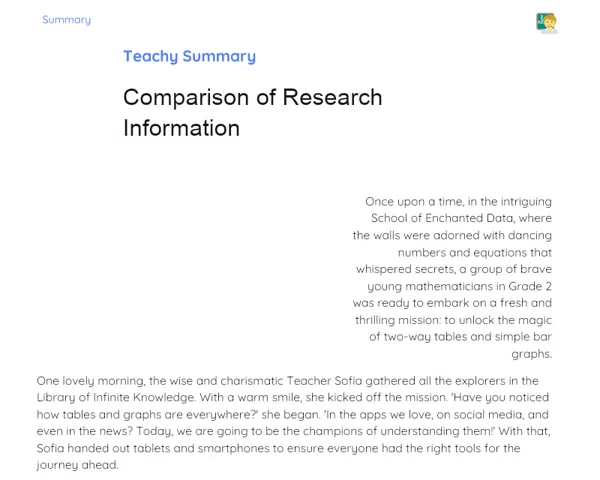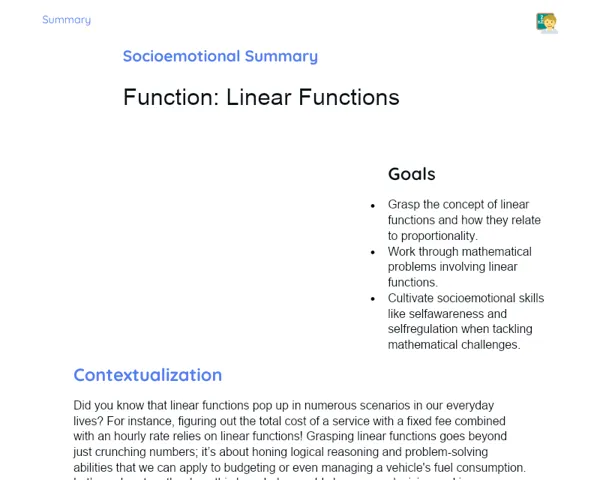Summary Tradisional | Perimeter: Circle
Contextualization
The perimeter of a geometric shape refers to the total distance around its edges. For circles, this measurement is called the circumference. To figure out the circumference of a circle, we use the formula P = 2πr, where 'P' stands for the perimeter, 'r' is the radius of the circle, and 'π' (pi) is a mathematical constant that's roughly equal to 3.14159. The radius measures the distance from the centre of the circle to any point along its edge, and the diameter is simply twice the radius, stretching from one side of the circle to the other through the centre.
The constant π is one of the most intriguing and vital numbers in mathematics. It isn’t just an approximation but an irrational number, meaning its decimal places go on forever without repeating. π turns up in various fields of science and engineering, so understanding how it connects to the circumference of a circle is crucial for practical applications, whether you're calculating the circumference of circular objects or tackling complex physics and architecture challenges.
To Remember!
Definition of Perimeter in Circles
The perimeter of a circle, or circumference, is the distance around the circle's edge. To find this measurement, we use the formula P = 2πr, where 'P' represents the perimeter, 'r' is the radius of the circle, and 'π' (pi) is the aforementioned constant close to 3.14159. The radius is the distance from the centre of the circle to any point on its perimeter. This formula is based on the relation between the perimeter and the diameter of the circle, where the diameter equals twice the radius.
Grasping the definition of the perimeter of circles is essential for solving geometrical problems that involve round shapes. For instance, if you need to determine how much material you'd require to surround a circular garden, knowing the circumference is key. This formula sees widespread use in lots of scientific and engineering fields, from constructing round buildings to designing computer graphics and animations.
You can see this formula in everyday scenarios, like measuring the edge of a pizza or the wheel of a bicycle. When students comprehend the definition and formula for perimeter, they can apply it across different contexts and tackle mathematical problems with better efficiency.
-
The perimeter of a circle measures the distance around its edge.
-
The formula for calculating the perimeter is P = 2πr.
-
The radius is the distance from the centre of the circle to any point along its edge.
Relationship Between Perimeter and Diameter
The link between the perimeter and diameter of a circle is one of the most significant and interesting properties in geometry. This relationship can be described with the formula P/D = π, where 'P' is the perimeter and 'D' is the diameter of the circle. Essentially, any circle's perimeter is always π times its diameter. This means that no matter how big or small the circle is, the ratio between the perimeter and the diameter will always equal the constant π.
The diameter of a circle is double the radius (D = 2r). We can rework the perimeter formula as P = 2πr by making this substitution. This connection is crucial for understanding circular measurements and solving related problems. For example, if we know a circle's diameter, we can easily find its perimeter using the constant π.
This relationship has practical implications in fields such as civil engineering, where it's vital for designing and building round structures. Understanding this relationship helps students apply this knowledge in real-world situations and develop essential skills for overcoming challenges.
-
The ratio between the perimeter and diameter of a circle is always π.
-
The diameter equals twice the radius (D = 2r).
-
The perimeter formula can be expressed as P = 2πr.
Importance of the Value of π
The value of π, around 3.14159, stands as one of the most essential constants in mathematics. As an irrational number, π has decimal places that stretch infinitely without falling into a repeating pattern. This character makes π a captivating number full of mathematical intrigue. You'll find the constant π featured in several mathematical and scientific formulas, especially those involving circular and spherical shapes.
Beyond circle geometry, π is pivotal in various science and engineering areas. For instance, it figures in calculations for areas and volumes of three-dimensional shapes like spheres and cylinders. It’s also critical in physics, as it appears in formulas that deal with wave phenomena and fluid dynamics. In engineering, π is indispensable for constructing round structures like bridges and tunnels.
Comprehending the importance of π helps students apply this knowledge in diverse contexts and work through complex problems. Furthermore, grasping π and its irrational properties is crucial for developing advanced maths skills and appreciating the complexity and beauty of mathematics.
-
π is an irrational number with infinite decimal places.
-
Approximately, π is equal to 3.14159.
-
π is used in a range of mathematical and scientific formulas.
Practical Examples of Calculating the Perimeter
To solidify understanding about calculating the perimeter of a circle, it’s beneficial to look at practical examples that show how to apply the formula P = 2πr. Imagine a circle with a radius of 3 cm. Using the formula, we calculate the perimeter as P = 2π(3) = 6π. Plugging in the approximate value of π, we find P ≈ 6 × 3.14159 = 18.85 cm. This straightforward case illustrates how the formula works for finding the perimeter.
Another example could be a circle with a radius of 7 cm. Applying the formula gives us P = 2π(7) = 14π. By using the estimated value of π, we get P ≈ 14 × 3.14159 = 43.98 cm. These examples reinforce the idea that the circumference of a circle directly correlates to its radius, and that π is critical for these calculations.
In addition to numerical examples, consider practical real-life applications, like measuring the edge of round items you encounter every day. For example, calculating the circumference of a bottle cap or a bike wheel. These examples help students visualise how theoretical concepts play out in real life, making learning more relevant and engaging.
-
The formula P = 2πr is used for calculating a circle's perimeter.
-
Example: For a circle with a radius of 3 cm, the perimeter is approximately 18.85 cm.
-
Practical applications include measuring the edge of round objects like caps and wheels.
Key Terms
-
Perimeter: The measure around the edge of a geometric figure.
-
Circle: A flat geometric figure where all points are at an equal distance (radius) from the centre.
-
Radius: The distance from the centre of the circle to any point on its edge.
-
Diameter: The length of a straight line cutting across the circle through the centre, being double the radius.
-
π (pi): A mathematical constant approximately equal to 3.14159, representing the ratio between a circle's perimeter and its diameter.
-
Irrational number: A number that can’t be expressed as an exact fraction and has infinite, non-repeating decimal places.
Important Conclusions
In this lesson, we delved into the concept of perimeter in circles, realising that the distance around a circle is termed circumference and can be computed using the formula P = 2πr. We examined the vital relationship between the perimeter and the diameter of the circle, emphasising that the ratio of these two measurements is always π, a mathematical constant that is around 3.14159. Furthermore, we underscored the significance of the value of π, noted for being an irrational number with infinite decimal points, which is crucial for a variety of mathematical and scientific calculations.
By working through practical examples of calculating the perimeter for circles with different radii, students could see how the formula P = 2πr is applied in real-life contexts. We also discussed converting between radius and diameter, noting that the diameter is twice the radius (D = 2r), which simplifies matters when only the diameter is known. These concepts are fundamental for addressing geometric problems and have practical implications across many fields, like engineering and physics.
Comprehending a circle's perimeter and the importance of π allows students to apply this knowledge in everyday scenarios like measuring the edges of round items. This understanding is vital for honing mathematical skills and solving intricate problems, preparing students for future academic and practical challenges. We encourage students to keep exploring this fascinating topic and uncover its many applications.
Study Tips
-
Practice calculating the perimeter of various circular objects you come across daily, like bottle lids, plates, and bike wheels. This will help reinforce your understanding of the P = 2πr formula.
-
Review the correlation between radius, diameter, and perimeter. Ensure you know how to switch between these measurements and use the constant π in your calculations.
-
Dig deeper into the number π, its unique properties, and its applications in other areas of maths and science. This will enhance your understanding and appreciation of the significance of this mathematical constant.



